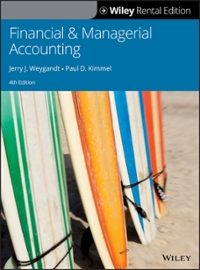Question
1.If the high-low points method is used, the results when compared to those under the method of least squares are Variable cost per unitTotal fixed
1.If the high-low points method is used, the results when compared to those under the method of least squares are
Variable cost per unitTotal fixed costs
a.EqualEqual
b.Higher by P1.26Lower by P2, 850
c.Lower by P1.26Higher by P2, 850
d.Higher by P5Lower by P1, 500
2.Which of the following costs is not a product?
a.Wages paid to workers for rework on defective products
b.Wages paid to truck loaders who load finished goods onto outgoing delivery trucks
c.Fringe benefits paid to factory workers
d.Wages paid to workers to idle time due to machine breakdown in a production department
3.ABC differs from traditional product costing because it uses multiple allocation bases and therefore, allocates costs (such as overhead costs) more accurately. This normally results in
a.Equalizing set up costs for all product lines
b.Lower set up costs being charged to low volume products
c.Decreased units' costs for low-volume products than is reported by traditional product costing systems
d.Substantially greater unit costs for low-volume products than is reported by traditional product costing system.
4.The allocation base that would most likely be the best for allocating the indirect costs of marketing function is
a.Number of shipments
b.Number of salespersons
c.Number of customer phone calls
d.Direct labor hours
5.The allocation base that would be most likely to be the best for allocating the indirect costs of the distribution function is
a.Number of shipments
b.Number of salespersons
c.Direct labor hours
d.Machine hours
6.Of the following, which is the best reason for using the activity-based costing?
a.To assign indirect overhead costs to different overhead pools
b.To better assign overhead costs to products
c.To keep better track of overhead costs
d.To more accurately assign overhead costs to cost pool so that these costs are better controlled
6.A cost that remains constant in totals but varies in a per unit basis with changes in activity is called
a.Expired cost
b.Fixed cost
c.Variable cost
d.Mixed cost
7.Which of the following is not a product cost component?
a.Rent on a factory building
b.Indirect production labor wages
c.Janitorial supplies used in factory
d.Commission on the sale of a product
8.The indirect cost of converting raw material into finished goods are called
a.Period costs
b.Prime costs
c.Overhead costs
d.Conversion costs
9.Conversion cost does not include
a.Direct labor
b.Direct material
c.Factory depreciation
d.Supervisor's salaries
10.The distinction between the direct and indirect costs depends on whether the cost
a.Is controllable or non-controllable
b.Is variable or fixed
c.Can be conveniently and physically traced to a cost object under consideration
d.Will increase with changes in levels of activity
11.Edge Cut Company is a construction company that builds greenhouses on special request.What is the proper classification of the carpenter's wages?
ProductPeriodDirect
a.Yes,YesNo
b.Yes,NoYes
c.NoNoNo
d.NoYesYes
12.All costs related to manufacturing function of a company are
a.Prime costs
b.Direct costs
c.Product costs
d.Conversion costs
13.Which of the following statements are true?
I.A company that produces sugar will use a process costing system to track production cost
II.A company that produces custom bridal gown will use a job order costing system to track production cost
a.Both I and II
b.I only
c.II only
d.None of the statements are true
14.Which of the following statements are true?
I.In a normal job order costing system, factory overhead is applied using predetermined rates times actual input
II.In a job order costing system, costs are accumulated for each individual job
a.I only
b.II only
c.Both I and II
d.None of the statements are true
15.Over-applied overhead that is material in amount is allocated between Finished Goods inventory, Work in process Inventory and Cost of Goods sold at year end. Over-applied factory overhead that is immaterial in amount is closed to Cost of Goods Sold at year end.
a.First and second sentence are true
b.First and second sentence are false
c.Only the first statement is true
d.Only the second statement is true
16.Process costing is most appropriate when manufacturing large batches of homogeneous products. Conversion cost includes all manufacturing cost other than direct materials.
a.First and second sentence are true
b.First and second sentence are false
c.Only the first statement is true
d.Only the second statement is true
17.Under applied overhead occurs when
a.Actual overhead is less than applied overhead
b.The actual overhead rate is less than the predetermined overhead rate
c.The predetermined overhead rate is less than the actual rate
d.The predetermined overhead rate is overstated
18.A security guard's wages at a factory would be an example of:
Indirect laborFixed manufacturing overhead
a.NoNo
b.YesYes
c.YesNo
d.NoYes
Step by Step Solution
There are 3 Steps involved in it
Step: 1

Get Instant Access to Expert-Tailored Solutions
See step-by-step solutions with expert insights and AI powered tools for academic success
Step: 2

Step: 3

Ace Your Homework with AI
Get the answers you need in no time with our AI-driven, step-by-step assistance
Get Started


